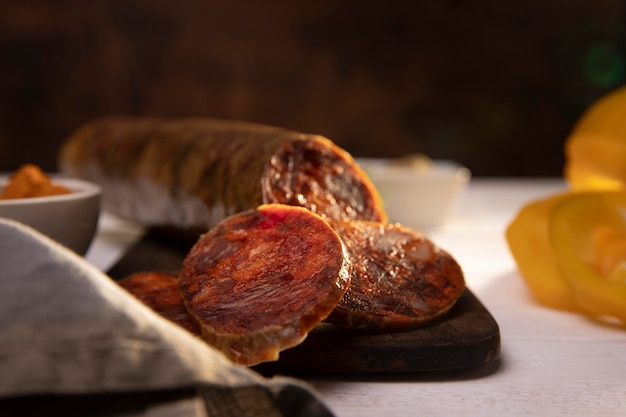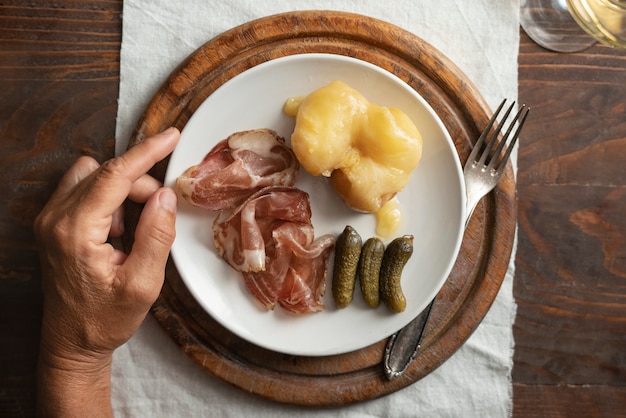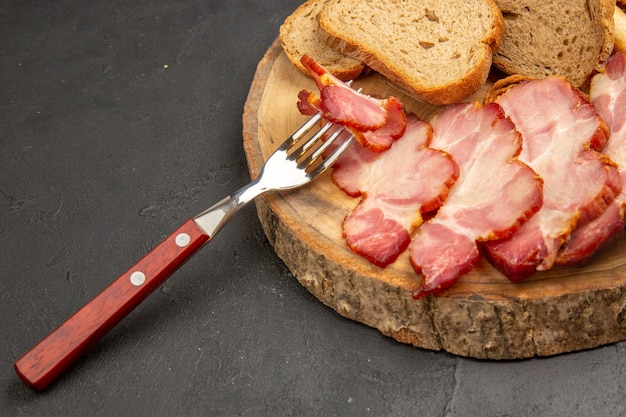Right, let's talk hams, shall we? You know, those glorious hunks of meat that are perfect for a Sunday roast, a festive gathering, or just a simple, comforting dinner on a chilly evening. I'm a big fan, and I've been cooking them for years, trying all sorts of tricks and techniques along the way. But cooking a bone-in ham can feel a bit daunting, especially if you're new to the game. How long do you cook it? What temperature should it be? Well, don't you worry, my culinary friend, I'm here to walk you through it, sharing everything I've learned about achieving that perfect ham. So, grab your apron, get your favourite mug of tea brewing, and let's get cooking!
Part 1: Understanding Your Ham - A First Look

Before you even start thinking about cooking, you need to know what kind of ham you're working with. There are a few main types, and each one requires a slightly different approach.
A Quick Look at Ham Varieties
- fresh ham: This is a raw ham that's been cured but not cooked. It's typically sold whole, with the bone in. You'll need to cook this one through before you can eat it. Think of it as a blank canvas, ready for your culinary artistry. You can create a symphony of flavours with this kind of ham!
- cured ham: This ham has been cured and smoked, and it's ready to eat. It's often sold pre-sliced or whole, and it can be eaten cold or reheated. You don't need to cook it, but you can reheat it if you prefer. Think of this as the "ready-to-go" option. It's perfect for those quick meals when you don't have a lot of time.
- cooked ham: This ham has already been fully cooked and ready to eat. It's often sold pre-sliced or whole, and it can be eaten cold or reheated. You can enjoy this one right away, with no fuss!
For this article, we're focusing on the fresh, bone-in ham, because that's the one that gives you the most flexibility in terms of flavours and cooking techniques. Now, let's talk about the size of the ham, because that's a crucial factor in determining cooking time.
Knowing Your Ham's Size - The Weighing Game
The size of your ham will play a big role in determining how long you need to cook it. If you're dealing with a whopper of a ham, you'll need to cook it for longer than a smaller ham. It's always a good idea to check the package for cooking instructions, but I'll be sharing some general guidelines that work for most hams.
For example, I once had a ham that was about 10 pounds. It took a good 3 hours to cook to perfection. On the other hand, I've cooked a smaller 5-pound ham in a little over 2 hours. So, keep the size of your ham in mind as you plan your cooking time. It's a bit like baking a cake, the bigger the cake, the longer it takes to bake!
Part 2: The Right Equipment for the Job - Getting Ready to Cook

Alright, you've got your ham, now let's gather the tools to conquer this culinary adventure. You'll want to make sure you have the right equipment for the job.
The Oven's the Place to Be
For most bone-in hams, your oven is the best place to achieve that perfect roast. You can use a conventional oven, but I personally prefer using a slow cooker for a more tender, succulent result. It's like giving your ham a warm hug for hours! But no matter which one you choose, make sure your oven is preheated before you pop the ham in. This helps ensure that the ham cooks evenly and doesn't end up with cold spots. Nobody wants a ham that's got cold patches! It's all about a consistent, delicious experience.
Don't Forget the roasting pan
Now, you'll need a decent roasting pan. It needs to be big enough to hold your ham and any liquid you might be using. If you're using a slow cooker, well, that's a no-brainer! The pan will also need to be oven-safe. We don't want a meltdown in the middle of cooking! You want a pan that can handle the heat and keep your ham safe and sound.
A Thermometer's Your Friend - Measuring the Magic
Speaking of ovens, this is where a meat thermometer comes in handy. It's the ultimate tool for making sure your ham is cooked through without overdoing it. You'll want to check the internal temperature of the ham, and I'll tell you exactly where to aim for in the next section. The thermometer is your trusty guide to culinary perfection. It's like having a little chef whispering in your ear, "It's time to take it out, my dear!"
Part 3: Getting Ready to Cook - The Pre-Game Prep

Alright, you've got your ham, your oven, and your thermometer. Now, let's get this ham ready to go! This is where we get to do some pre-game prep, which sets the stage for a culinary triumph.
The Pre-Cook Prep - A Little TLC
Before you toss that ham in the oven, give it a little TLC. First, wash the ham with cold water and pat it dry. This helps get rid of any excess salt or moisture. Then, you can score the fat. Scoring the fat doesn't just make it look fancy, it actually helps the ham cook more evenly and allows the flavours to penetrate deeper. I use a sharp knife to make a series of diagonal cuts across the fat. It's not rocket science, trust me. Just imagine those little cuts as doors that allow the delicious flavours to flood in!
The Magic of Glaze - A Touch of Sweetness
Now, for the fun part. Glazing your ham is a great way to add flavour and a beautiful golden colour. There are tons of glazes out there, but I love a simple honey-mustard glaze. Just combine honey, mustard, and a little bit of brown sugar in a bowl, mix it up, and brush it all over the ham. You can add a sprinkle of brown sugar on top for extra sweetness and a lovely crust. Now, you're ready to cook! Think of the glaze as a delicious hug, adding that extra layer of flavour and beauty to your ham. It's like the final flourish that elevates your dish to a whole new level!
Part 4: Cooking Your Ham to Perfection - The Main Event
Now, this is where things get serious. We need to make sure our ham reaches that perfect temperature. But first, how long do we cook it?
The Time-Tested Method - A General Guide
Here's a general guideline for cooking your bone-in ham. Keep in mind that this is a starting point, and you might need to adjust the cooking time based on your specific ham and oven. It's like baking, sometimes you need to adjust the time depending on your oven's quirks.
Approximate Cooking Time:
| Ham Weight (pounds) | Cooking Time (hours) |
|---|---|
| 10-12 | 2-3 |
| 12-14 | 3-4 |
| 14-16 | 4-5 |
Remember, these are just estimates. The best way to know for sure is to use your trusty meat thermometer. That's where we move on to the next step. It's always better to err on the side of caution, but the thermometer will be your ultimate guide!
The Internal Temperature Tells All - The Culinary Compass
You need to make sure your ham reaches an internal temperature of 145°F (63°C). I repeat, 145°F (63°C)! This is the safe temperature to ensure the ham is cooked through. You can use a meat thermometer to check the internal temperature. Insert the thermometer into the thickest part of the ham, making sure it doesn't touch the bone. The thermometer is like your culinary compass, guiding you to that perfect internal temperature. It's essential for ensuring your ham is cooked through and safe to eat.
Don't Forget the Rest - The Finishing Touch
Once the ham reaches that magic temperature, take it out of the oven and let it rest for 10-15 minutes before carving. This allows the juices to redistribute throughout the ham, resulting in a juicier, more tender cut. You know, like when you rest a good steak, it makes all the difference! This little rest period is like a spa treatment for your ham, allowing it to relax and redistribute its delicious juices. It's the secret to achieving that perfect tender, juicy texture.
Part 5: Exploring Different Cooking Methods - The culinary journey
Now, let's venture beyond the traditional oven and explore some other cooking methods that can elevate your ham experience.
The Slow Cooker's Gentle Touch - A Slow and Steady Approach
If you're after a truly melt-in-your-mouth ham, the slow cooker is your best friend. It's a super easy method, and it yields a tender ham that's practically falling apart. Just place the ham in your slow cooker, pour a cup of water or broth into the bottom, and cook on low for 6-8 hours. You can add some flavour to the cooking liquid by adding a cup of apple cider or a few bay leaves. Think of the slow cooker as the ultimate comfort zone for your ham. It's a gentle, slow approach that allows the flavours to meld and create a symphony of deliciousness.
The instant pot's Speed Demon - Fast and Furious Cooking
Want your ham done quickly? The Instant Pot is a game-changer. It cooks your ham under pressure, dramatically reducing the cooking time. The pressure cooking method also makes for a really tender and juicy ham. You'll need to sear the ham first in the Instant Pot to get a lovely crust, then add some broth or water and cook for 60-90 minutes, depending on the size of your ham. This method is perfect for those times when you need a delicious meal in a hurry. The Instant Pot is like a culinary superhero, whipping up a delicious ham in record time!
Grilling for a Smoky Flair - Summertime Cooking
For a smoky, barbecue-style flavour, consider grilling your ham. It's a great option for a summer cookout. Just make sure you have a grill large enough to accommodate your ham, and preheat it to medium heat. Place the ham on the grill and cook it for about 2-3 hours, flipping it over every hour to ensure even cooking. You can add a smoky flavour by using wood chips soaked in water on your grill. Grilling is perfect for those warm summer days, bringing that smoky aroma and flavour that makes for a truly memorable meal. It's a great way to celebrate those long summer evenings.
Part 6: Carving Your Ham Like a Pro - The Art of Carving
So, your ham is cooked to perfection, rested, and ready to be carved. But don't panic, it's not as complicated as it might seem. Let me share some carving tips that'll make you feel like a seasoned chef.
Tools of the Trade - The Carving Arsenal
You'll need a sharp carving knife, a sturdy carving board, and a couple of forks. The carving knife should be long and thin, with a slightly curved blade. This will help you make clean, precise cuts. The carving board should be large enough to hold the entire ham. You don't want your ham sliding all over the place! It's about having the right tools to make your carving experience smooth and efficient.
Carving the Ham - A Step-by-Step Guide
1. Start by carving away the fat around the bone. This will give you a clearer view of the meat.2. Next, carve slices of meat from the thickest part of the ham. The cuts should be about half an inch thick. It's all about that perfect balance between thickness and thinness. 3. As you carve, you'll notice some bone sticking out. Use your knife to carefully cut around the bone.4. Once you've carved all the meat from one side, flip the ham over and repeat the process on the other side. You're aiming for a smooth, even carving, like a sculptor revealing the beauty of their masterpiece.
You can also carve the ham into smaller portions, like ham steaks, if you prefer. Just cut the ham into thick slices, removing the bone before you slice. This is a great way to make smaller portions, perfect for individual servings or for making ham sandwiches.
Part 7: Serving and Storing Your Ham - The Final Touches
You've cooked the perfect ham, carved it beautifully. Now it's time to serve it up and enjoy! This is where you get to showcase your culinary prowess and delight your taste buds.
Serving Your Ham - A Feast for the Senses
There are so many ways to serve your ham. You can go classic with some mashed potatoes, green beans, and gravy. Or you can get creative with a pineapple salsa, mango chutney, or even a sweet and spicy glaze. The sky's the limit! It's all about finding the combinations that tickle your fancy and create a symphony of flavours.
Storing Your Leftovers - Keeping the Goodness
If you have leftovers, store them in an airtight container in the refrigerator for up to 3-4 days. You can also freeze your leftover ham for up to 2-3 months. Just make sure you wrap it tightly in plastic wrap and aluminum foil. When you're ready to use it, thaw the ham in the refrigerator overnight. You don't want to waste any of that deliciousness! Freezing is a great way to extend the life of your ham and enjoy it later.
Part 8: FAQs - The Culinary Q&A
1. Can I cook a ham in a slow cooker?
Yes, absolutely! A slow cooker is a great option for a tender, juicy ham. Just place the ham in the slow cooker, pour a cup of water or broth into the bottom, and cook on low for 6-8 hours. You can also add some flavour to the cooking liquid by adding a cup of apple cider or a few bay leaves. The slow cooker is like a warm hug for your ham, creating a tender, succulent masterpiece.
2. Can I overcook a ham?
Yes, it's possible to overcook a ham. If you overcook it, the meat will become dry and tough. That's why it's important to use a meat thermometer to check the internal temperature of the ham. The thermometer is your culinary guardian, ensuring you don't overcook and ruin your delicious ham.
3. How do I reheat a ham?
You can reheat a ham in the oven, slow cooker, or microwave. To reheat in the oven, place the ham in a baking dish and bake at 325°F (160°C) for 30-45 minutes. To reheat in the slow cooker, place the ham in the slow cooker and cook on low for 2-3 hours. To reheat in the microwave, place the ham in a microwave-safe dish and heat on high for 1-2 minutes, depending on the size of the ham. Choose the reheating method that best suits your needs and preferences.
4. What are some good side dishes for ham?
There are so many great side dishes that pair well with ham. Some classics include mashed potatoes, green beans, peas, and carrots. You can also get creative with roasted vegetables, sweet potato casserole, or fruit salad. The beauty of ham is its versatility; it pairs well with so many different side dishes. It's like a culinary chameleon, adapting to your taste and preferences.
5. Can I make my own glaze for the ham?
Absolutely! There are endless possibilities for ham glazes. You can use a combination of honey, mustard, brown sugar, maple syrup, orange juice, or even pineapple juice. Just experiment and see what you like best. Let your creativity run wild, and don't be afraid to experiment! There's no right or wrong way to create a delicious glaze.
Part 9: Final Thoughts - The Culinary Journey Continues
There you have it, my guide to cooking a bone-in ham to perfection. It might seem like a lot of information, but trust me, it's not as complicated as it looks. Just follow the steps, be patient, and you'll be rewarded with a delicious ham that's sure to impress your family and friends. Remember, cooking is all about having fun and experimenting. So, don't be afraid to try new things, and most importantly, enjoy the process! Now, go forth and cook! May your culinary journey be filled with joy and deliciousness.
Everyone is watching

How to Cook Frozen Lobster Tails Perfectly: A Step-by-Step Guide
RecipesLobster. Just the word conjures up images of lavish meals, special occasions, and a taste of luxury. But let's...

Pigs in a Blanket Cooking Time: How Long to Bake for Perfect Results
RecipesAh, pigs in a blanket. Just the name conjures up images of those delightful little parcels of crispy pastry en...

Pork Fillet Cooking Time: How Long to Cook It Perfectly
RecipesPork fillet, or tenderloin as it's sometimes called, is a real favourite in our house. It's so versatile, and...

The Ultimate Guide to Tender, Juicy Pulled Pork
RecipesRight, let's talk pulled pork. It's one of those dishes that just screams "comfort food," doesn't it? I mean...

The Ultimate Guide to Cooking Sweet Potatoes: From Roasting to Mashing
RecipesSweet potatoes. Just the name conjures up images of warm, comforting dishes, bursts of vibrant color, and a to...
